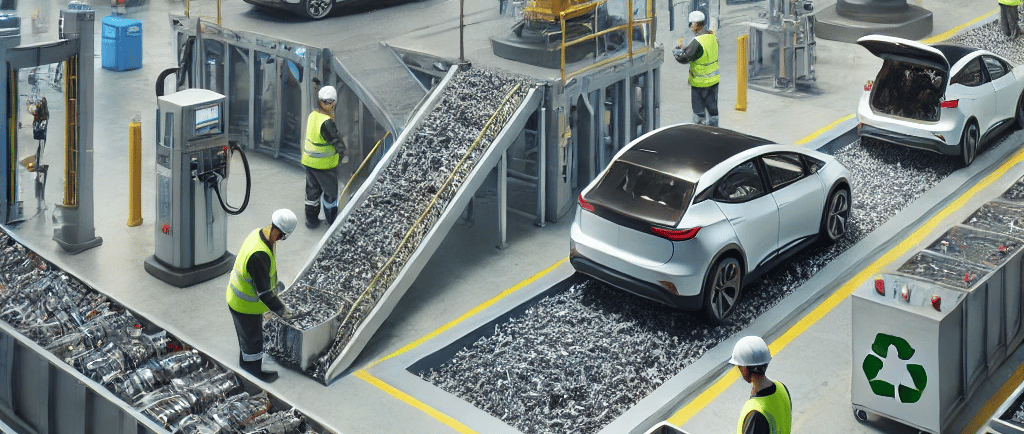Innovations in Catalytic Converter Recycling: Adapting to EV Growth
Discover how the rise of electric vehicles (EVs) is transforming catalytic converter recycling. Learn about advanced metal recovery technologies, shifting PGM demand, and how recyclers can pivot to hydrogen fuel cell and battery recycling to stay ahead in a changing industry.
SUSTAINABLE METALS & RECYCLING INNOVATIONS


Introduction
The automotive industry is undergoing a seismic shift as electric vehicles (EVs) rapidly replace internal combustion engine (ICE) vehicles. While this transition is essential for reducing carbon emissions and promoting sustainability, it significantly impacts industries reliant on ICE components—one of the most notable being catalytic converter recycling.
Why Catalytic Converter Recycling Matters
Catalytic converters contain precious metals such as platinum, palladium, and rhodium (collectively known as platinum group metals – PGMs), which are vital for:
Neutralizing harmful vehicle emissions
Electronics manufacturing (circuit boards, semiconductors)
Medical instruments & chemotherapy drugs
Hydrogen fuel cells for clean energy
Since mining PGMs is costly and environmentally damaging, recycling catalytic converters is the most sustainable way to source these critical materials. In fact, up to 30% of global PGM demand is met through recycling.
However, as EV adoption grows, demand for catalytic converters will decline, disrupting the supply chain for recycled PGMs. How will the recycling industry adapt?
1. The Importance of Catalytic Converter Recycling
How Do Catalytic Converters Work?
Catalytic converters reduce vehicle emissions by converting harmful gases such as:
✔ Carbon monoxide (CO) → into carbon dioxide (CO₂)
✔ Nitrogen oxides (NOx) → into harmless nitrogen and oxygen
✔ Hydrocarbons (HCs) → into water and CO₂
This process is made possible through the PGM-coated ceramic structure inside catalytic converters.
Why PGMs Are Critical Across Industries
PGMs extracted from catalytic converters are essential for multiple industries:
🔹 Electronics: Used in circuit boards and semiconductors
🔹 Medical: Applied in chemotherapy drugs and medical instruments
🔹 Hydrogen Fuel Cells: Enable clean energy solutions in hydrogen-powered vehicles
As mining operations struggle to meet demand, recycling PGMs remains a key sustainability driver.
2. The Shift Away from ICE Vehicles: A Challenge for Recycling
The Decline of Gasoline-Powered Vehicles
📊 Fact: BloombergNEF predicts that EVs will represent 58% of new car sales globally by 2040.
How This Affects Catalytic Converter Recycling
❌ Fewer ICE vehicles = fewer end-of-life catalytic converters available for recycling
❌ PGM supply from recycled sources will shrink
❌ Traditional catalytic converter recycling businesses must pivot to new markets
How Recyclers Can Adapt to an EV-Dominated World
✅ Refine metal extraction techniques to maximize PGM recovery
✅ Seek alternative sources of PGMs, such as electronic waste (e-waste)
✅ Expand into new revenue streams (hydrogen fuel cell & battery recycling)
3. Challenges Facing Catalytic Converter Recycling in an EV-Driven Market
A. Declining Supply of Used Catalytic Converters
🔹 ICE vehicle phase-out = fewer scrap catalytic converters
🔹 Global EV incentives will accelerate ICE decline
💡 Solution:
Develop high-efficiency metal extraction to get more PGMs per converter
Source PGMs from e-waste (circuit boards, semiconductors)
Diversify into alternative recycling sectors
B. Changing Market Dynamics for PGMs
📉 Declining demand: Palladium & Rhodium (primarily used in gasoline catalytic converters)
📈 Rising demand: Platinum (needed for hydrogen fuel cell technology)
💡 Industry Insight: Johnson Matthey’s PGM Market Report forecasts a 20% rise in platinum demand by 2030 due to hydrogen fuel cell adoption.
C. Adapting Recycling Infrastructure
🔧 Recyclers must upgrade operations to remain profitable
✅ High-Yield Metal Recovery: Invest in hydrometallurgical and bioleaching processes
✅ Automation & AI Sorting: Use AI-driven sorting to maximize efficiency
✅ Expand Into Battery Recycling: Recover cobalt, lithium, and nickel from EV batteries
4. Opportunities for Catalytic Converter Recyclers Amid EV Growth
A. Advanced Metal Recovery Technologies
♻ Hydrometallurgical Processing – Extracts PGMs with higher yields and lower emissions
🦠 Bioleaching with Microorganisms – Uses bacteria to recover PGMs without toxic chemicals
💡 Companies like Umicore & BASF are investing in next-gen recycling tech for sustainable, high-yield PGM extraction.
B. Pivoting to Hydrogen Fuel Cell Recycling
📈 Platinum demand is increasing due to hydrogen fuel cells.
🔹 Fuel Cell Electric Vehicles (FCEVs) need platinum-based catalysts
🔹 Recyclers can repurpose PGMs for hydrogen energy applications
💡 Opportunity: Recyclers that shift toward hydrogen energy will remain profitable.
C. Expanding into Battery & E-Waste Recycling
📈 With fewer catalytic converters in circulation, recyclers can pivot into:
✅ Electronic Waste (E-Waste) Recycling – Circuit boards contain gold, silver, and platinum
✅ EV Battery Recycling – Recover lithium, cobalt, and nickel for next-gen batteries
💡 Future-Proofing Strategy: Multi-material recycling ensures long-term business sustainability.
5. Future Trends in Recycling & Sustainability
A. Sustainable PGM Recovery Methods
🔹 Low-energy extraction will become industry standard
🔹 Recyclers will transition to green chemistry solutions
B. Growth in Hydrogen Fuel Cell Recycling
🔹 More catalytic converter recyclers will shift toward fuel cell vehicle (FCV) applications
C. AI-Powered Sorting & Automation
🔹 AI-driven metal sorting will increase efficiency in PGM recovery
D. Battery & E-Waste Recycling Dominance
🔹 As catalytic converter volumes decline, battery recycling will take center stage
💡 Bottom Line: Sustainability-driven innovation will dictate the future of recycling.
Conclusion
🚗 The EV revolution is reshaping the catalytic converter recycling industry.
💡 How Recyclers Can Adapt:
✅ Invest in advanced metal recovery technologies
✅ Diversify into hydrogen fuel cell & battery recycling
✅ Expand operations into e-waste recycling
🔹 Companies that innovate & pivot will dominate the next era of sustainable metal recovery.
Want to Stay Ahead in Recycling Innovations?
📩 Sign up for our newsletter to get insights on PGM recovery, sustainable energy solutions, and the future of recycling! 🚀♻
